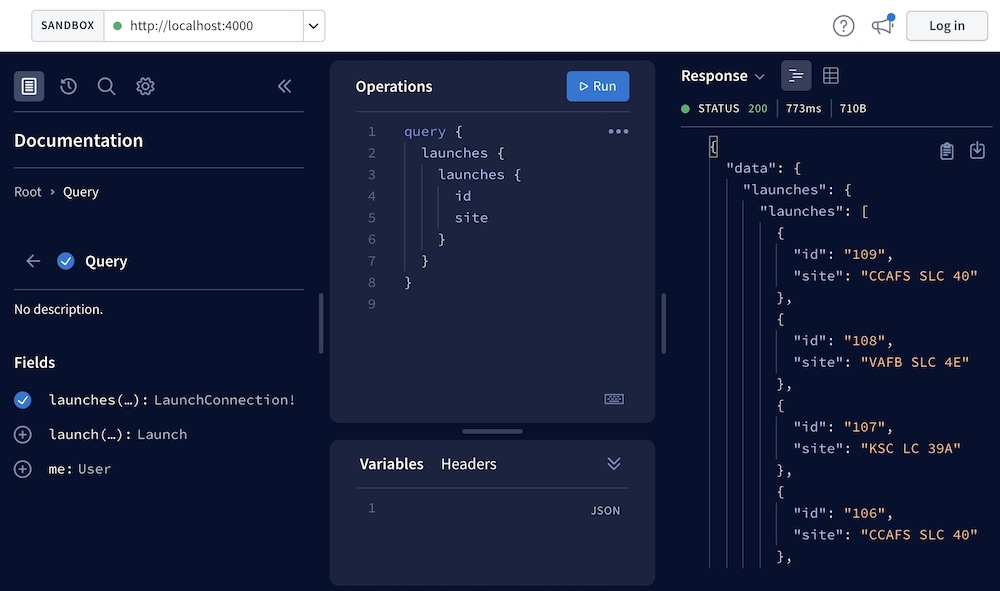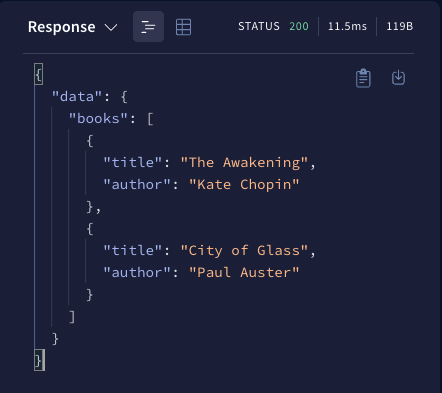Get Started with Apollo Server
这份教程可以帮你:
- 对 GraphQL 理念有基本的理解
- 定义一份符合你数据集结构的 GraphQL schema
- 运行一个 Apollo Server 实例,它可以让你根据 schema 执行 query
这份教程,假设你熟悉命令行和 JavaScript,并且已经安装了近期版本的 Node.js(v14.16.0)。另外,对于感兴趣的人,这份教程包含了如何用 TypeScript 设置 Apollo Server 的可选章节
Step 1:创建项目
- 为新项目创建一个目录:
mkdir graphql-server-example
cd graphql-server-example
- 使用
npm初始化 Node.js 项目(或者使用其他包管理器,例如 Yarn):
npm init --yes && npm pkg set type="module"
这份教程使用 ES Modules 设置项目,可以简化我们的示例并允许我们使用 top-level
await。
现在,你的项目包含了一个package.json文件。
Step 2:安装依赖
运行 Apollo Server 需要 2 个顶层依赖:
GraphQL(也被称作graphql-js)是实现核心 GraphQL 解析和执行算法的库。@apollo/server是 Apollo Server 自身主要的库。Apollo Server 知道如何将 HTTP 请求与响应转变为 GraphQL operation 并在支持插件和其他功能的、可扩展的上下文中运行它们。
运行下面的命令来安装这些依赖:
npm install @apollo/server graphql
Step 3:定义 GraphQL schema
下面的代码块默认使用 TypeScript。你可以使用每个代码块前的下拉菜单来切换到 JavaScript。
如果正在使用 JavaScript,在
.ts和.tsx出现的地方,使用.js和.jsx扩展名。
每个 GraphQL Server(包括 Apollo Server)使用 schema 来定义 client 可以 query 的数据的结构。在这个例子中,我们将创建一个 server,用于通过 title 和 author 来查询到 books 的集合。
打开index.ts
import { ApolloServer } from "@apollo/server";
import { startStandaloneServer } from "@apollo/server/standalone";
// A schema is a collection of type definitions (hence "typeDefs")
// that together define the "shape" of queries that are executed against
// your data.
const typeDefs = `#graphql
# Comments in GraphQL strings (such as this one) start with the hash (#) symbol.
# This "Book" type defines the queryable fields for every book in our data source.
type Book {
title: String
author: String
}
# The "Query" type is special: it lists all of the available queries that
# clients can execute, along with the return type for each. In this
# case, the "books" query returns an array of zero or more Books (defined above).
type Query {
books: [Book]
}
`;
添加
#graphql到模版字面量的开头,可以在一些 IDE 中开启 GraphQL 语法高亮。
这段代码定义了一个简单、有效的 schema。client 可以执行名为books的 query,并且我们的 server 将返回 0 或多个Book对象组成的数组。
Step 4:定义数据集
既然我们已经定义了数据的结构,我们就可以定义数据本身了。
Apollo Server 可以获取数据从你连接的任意数据源(包括数据库、REST API、静态对象存储服务或另一个 GraphQL server)。因为这份教程的目的,我们将硬编码我们示例使用的数据。
添加下面代码到index.ts文件底部:
const books = [
{
title: "The Awakening",
author: "Kate Chopin",
},
{
title: "City of Glass",
author: "Paul Auster",
},
];
这段代码定义了 client 可以查询的数据集。
注意,数组中的 2 个对象,每一个都符合我们在 schema 中定义的Book类型的结构。
Step 5:定义 resolver
我们已经定义了数据集,但是 Apollo Server 不知道当它执行 query 时,应该如何使用这些数据。为了解决这个问题,我们创建 resolver。
Resolver 告诉 Apollo Server 如何获取关联特定类型的数据。因为我们的Book数组是硬编码的,所以相应的 resolver 非常简单。
添加下面代码到index.ts文件底部:
// Resolvers define how to fetch the types defined in your schema.
// This resolver retrieves books from the "books" array above.
const resolvers = {
Query: {
books: () => books,
},
};
Step 6:创建 Apollo Server 实例
我们已经定义了 schema、数据集和 resolver。现在我们需要在初始化 Apollo Server 的时候,给它提供这些信息。
添加下面代码到index.ts文件底部:
// The ApolloServer constructor requires two parameters: your schema
// definition and your set of resolvers.
const server = new ApolloServer({
typeDefs,
resolvers,
});
// Passing an ApolloServer instance to the `startStandaloneServer` function:
// 1. creates an Express app
// 2. installs your ApolloServer instance as middleware
// 3. prepares your app to handle incoming requests
const { url } = await startStandaloneServer(server, {
listen: { port: 4000 },
});
console.log(`🚀 Server ready at: ${url}`);
这份教程使用 Apollo Server 的 standalone web server。如果你想集成 Apollo Server 到你在用的 web 框架,例如 Express,参考我们的web framework integration。
Step 7:运行 server
我们准备启动我们的 server!在项目根目录,执行以下命令:
npm start
现在,你应该在控制台底部看到了下面的输出:
🚀 Server ready at: http://localhost:4000/
成功!
Step 8:执行第一个 query
现在,可以在我们的 server 上执行 GraphQL query 了。为了执行第一个 query,我们可以使用 Apollo Sandbox。
在浏览器访问http://localhost:4000,它将打开 Apollo Sandbox:

Sandbox UI 包括:
- Operation 面板,用于编写和查询 query(在中间)。
- Response 面板,用于显示 query 的结果(在右边)。
- 标签页,用于 schema 查询、搜索和设置(在左边)。
- URL 输入框,用于连接其他的 GraphQL server(在左上角)。
我们的 server 支持一个名为books的 query,让我们来执行它!
这里是用来执行books的 GraphQL query 字符串:
query GetBooks {
books {
title
author
}
}
粘贴这段字符串到 Operation 面板并点击右上角的蓝色按钮。结果(从我们硬编码的数据集计算出)会出现在 Response 面板中:

注意:如果 Apollo Sandbox 无法找到你的 schema,确认是否通过将
introspection: true传递给ApolloServer构造函数,以开启 schema 的 introspection 功能。我们建议在生产环境中禁用 introspection 功能,因为它会暴露你的 schema 的细节。
GraphQL 最重要的理念之一,是 client 可以选择只查询它们需要的字段。从 query 字符串中删除author然后再执行。返回值更新为每个 book 对象只包含title字段!
完善示例
你可以在 Code Sandbox 访问并 fork 完整的示例代码:
进阶
这个示例应用是一个学习 Apollo Server 的良好开端。查看下面的资源,去学习更多关于 schema、resolver 和生成类型的基础:
想学习如何模块化和缩放 GraphQL API?查看 Apollo Federation Docs 以学习 federated 架构如何创建统一的、包含多个 GraphQL API 的 supergraph。
如果你想在特定 web 框架中使用 Apollo Server,参考我们的 list of integrations。如果我们没有你在用框架的集成方案,你可以创建一个以帮助我们的社区。